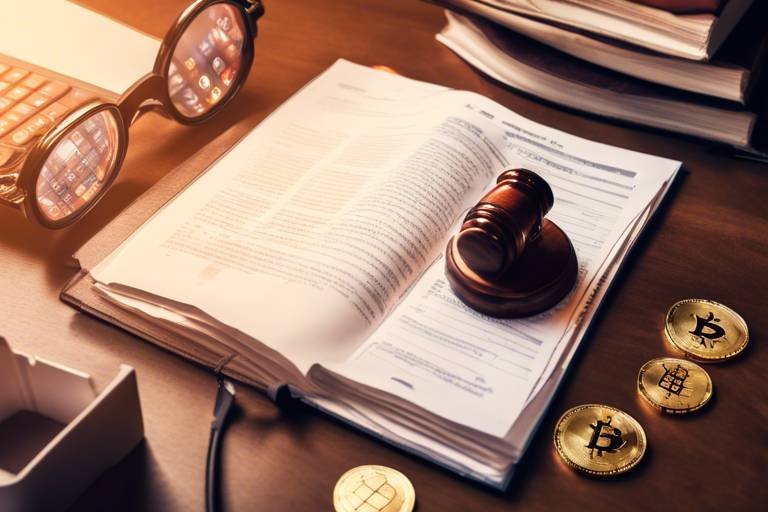The Role of Blockchain Technology in Ensuring Compliance
In today's rapidly evolving digital landscape, compliance has become a critical concern for organizations across various industries. Traditional methods of ensuring compliance often fall short, leading to inefficiencies and vulnerabilities. Enter blockchain technology, a game-changer that is reshaping how businesses approach compliance. By leveraging the unique characteristics of blockchain, organizations can enhance transparency, strengthen accountability, and streamline regulatory processes. But how exactly does blockchain achieve this? Let’s dive deeper to uncover the transformative role of blockchain in ensuring compliance.
At its core, blockchain is a decentralized digital ledger that records transactions across multiple computers in a way that ensures the data cannot be altered retroactively. This incredible technology is built on three fundamental principles: immutability, transparency, and security. Immutability means that once a transaction is recorded on the blockchain, it cannot be changed or deleted, providing a reliable audit trail. Transparency allows all participants in the network to view the same data, fostering trust among stakeholders. Lastly, security is bolstered through cryptographic techniques, ensuring that data remains safe from tampering and unauthorized access. Together, these principles form the backbone of blockchain's compliance capabilities, making it an invaluable tool for organizations striving to meet regulatory standards.
The benefits of blockchain technology in the realm of compliance are numerous and profound. One of the standout advantages is improved data accuracy. By eliminating intermediaries and enabling direct transactions, the risk of human error is significantly reduced. Additionally, blockchain enhances traceability, allowing organizations to track the journey of data and transactions in real-time. This level of visibility can be crucial during audits or investigations. Furthermore, the risk of fraud is markedly decreased, as the transparent nature of blockchain makes it challenging for malicious actors to manipulate data without detection.
One of the primary advantages of blockchain is its ability to ensure data integrity. With the help of cryptographic techniques, blockchain safeguards data against alterations, thus enhancing compliance with regulatory standards. This means that organizations can confidently present their data during audits, knowing that it is accurate and unaltered. The use of cryptography also ensures that sensitive information is secure, providing peace of mind to both organizations and their clients.
The immutability of blockchain records plays a crucial role in compliance. Once data is recorded on the blockchain, it cannot be changed, ensuring a reliable audit trail for regulatory purposes. This feature is particularly beneficial in industries where historical accuracy is paramount, such as finance, healthcare, and supply chain management. For instance, in the case of a financial institution, having an immutable record of transactions can prevent disputes and provide a clear history for regulators to review.
Blockchain also provides mechanisms for access control, allowing organizations to manage who can view or alter data. This capability is essential in supporting privacy requirements in compliance efforts. For example, in the healthcare sector, patient data must be protected under regulations like HIPAA. Blockchain can ensure that only authorized personnel have access to sensitive information, thus maintaining compliance while still allowing necessary data sharing.
Various industries are leveraging blockchain for compliance purposes. A notable example is the financial sector, where blockchain is used to create transparent transaction records that comply with anti-money laundering (AML) regulations. Another example can be found in the pharmaceutical industry, where blockchain helps track the supply chain of drugs, ensuring that counterfeit products do not enter the market. These real-world applications demonstrate how blockchain technology can effectively meet regulatory demands and enhance compliance across sectors.
Despite its benefits, implementing blockchain for compliance is not without challenges. Organizations often face technological barriers, as the integration of blockchain with existing systems can be complex. Additionally, regulatory uncertainties can hinder the implementation of blockchain solutions in compliance frameworks, as the evolving regulatory landscape poses challenges for blockchain adoption. Organizations must navigate these obstacles carefully to fully realize the potential of blockchain in compliance.
The evolving regulatory landscape poses challenges for blockchain adoption. Unclear regulations can create hesitation among organizations looking to implement blockchain solutions. Without a clear understanding of how regulations apply to blockchain technology, businesses may be reluctant to invest in it, potentially missing out on its compliance benefits.
Integrating blockchain with legacy systems can be a daunting task. Organizations often face technical challenges when trying to incorporate blockchain into their existing compliance processes. This integration requires not only technical expertise but also a cultural shift within the organization to embrace new technologies and processes.
Looking ahead, the future of blockchain technology in compliance appears promising. As more organizations recognize the benefits of blockchain, we can expect to see emerging trends and potential innovations that further enhance its role in compliance. Organizations can prepare for a more blockchain-centric compliance landscape by investing in training, exploring partnerships with blockchain experts, and staying informed about regulatory developments related to blockchain technology.
- What is blockchain technology? - Blockchain is a decentralized digital ledger that securely records transactions across multiple computers.
- How does blockchain enhance compliance? - By providing immutable records, enhanced data accuracy, and improved traceability, blockchain strengthens compliance frameworks.
- What industries are using blockchain for compliance? - Industries such as finance, healthcare, and pharmaceuticals are leveraging blockchain to meet regulatory requirements.
- What challenges exist in implementing blockchain for compliance? - Challenges include regulatory uncertainties and the integration of blockchain with existing systems.

Understanding Blockchain Technology
Blockchain technology is often described as a decentralized digital ledger that records transactions across a network of computers. Imagine a book that is not stored in one single location but is instead duplicated across countless copies worldwide. Each time a new transaction occurs, it is recorded in every copy of this book. This concept of decentralization is one of the fundamental principles that makes blockchain a game-changer in various industries. But what exactly does this mean for compliance? Let's break it down.
At its core, blockchain operates on three key principles: immutability, transparency, and security. These principles work in harmony to create a robust system that can enhance compliance across different sectors.
Immutability refers to the inability to alter or delete data once it has been recorded on the blockchain. This feature is crucial for compliance, as it ensures that all transactions are permanent and verifiable. Once an entry is made, it becomes part of the historical record, making it nearly impossible for malicious actors to tamper with the data. This characteristic not only protects the integrity of the information but also provides a reliable audit trail for regulatory purposes.
Transparency is another cornerstone of blockchain technology. Every participant in the network can access the same information, which fosters a culture of accountability. For instance, in industries like finance or supply chain management, stakeholders can track the movement of assets in real-time. This level of visibility reduces the chances of fraud and enhances trust among parties involved, which is vital for regulatory compliance.
Finally, security in blockchain is achieved through advanced cryptographic techniques. Each transaction is encrypted and linked to the previous one, creating a chain of blocks that is extremely difficult to break. This security layer protects sensitive information from unauthorized access and ensures that only those with the right permissions can view or modify the data. In a world where data breaches are increasingly common, blockchain offers a strong defense mechanism that can help organizations meet compliance requirements.
To summarize, the fundamental principles of blockchain technology—immutability, transparency, and security—work together to create a powerful tool for enhancing compliance. By ensuring that data remains unaltered, providing visibility into transactions, and protecting sensitive information, blockchain technology is paving the way for more robust regulatory frameworks across various industries.

Benefits of Blockchain for Compliance
In today's fast-paced world, compliance isn't just a box to check; it's a crucial aspect of maintaining trust and credibility in any business. Enter blockchain technology, a game-changer that enhances compliance across various industries. Imagine a world where every transaction is recorded in a way that is both transparent and secure. That's the power of blockchain.
One of the standout advantages of blockchain is its ability to improve data accuracy. Traditional systems often suffer from human error, leading to discrepancies that can cause compliance issues. With blockchain, data is entered once and then stored in a decentralized manner, minimizing the risk of errors. This means businesses can rely on accurate information, which is essential for meeting regulatory requirements.
Another significant benefit is enhanced traceability. Think of it like a digital breadcrumb trail that allows organizations to track every transaction from start to finish. This level of visibility is invaluable for audits and compliance checks. For instance, in the food industry, blockchain can trace the journey of a product from farm to table, ensuring that safety standards are met at every stage. This not only boosts consumer confidence but also helps businesses adhere to regulations.
Additionally, blockchain significantly reduces fraud risks. The technology's inherent security features, such as cryptographic hashing, make it extremely difficult for malicious actors to tamper with data. When organizations can demonstrate that their records are secure and unalterable, they not only comply with regulations but also build a reputation for integrity. This is especially important in sectors like finance, where trust is paramount.
To summarize, the benefits of blockchain for compliance can be highlighted as follows:
- Improved Data Accuracy: Reduces human error and discrepancies.
- Enhanced Traceability: Provides a clear audit trail for transactions.
- Reduced Fraud Risks: Increases data security and integrity.
In conclusion, blockchain technology is not just a trend; it's a revolutionary tool that can help organizations navigate the complex landscape of compliance with greater ease and effectiveness. By leveraging its benefits, businesses can foster a culture of transparency and accountability, which is increasingly demanded by regulators and consumers alike.
Q1: How does blockchain improve data accuracy?
A1: Blockchain improves data accuracy by storing information in a decentralized manner, reducing the chances of human error and discrepancies.
Q2: Can blockchain be used in all industries for compliance?
A2: Yes, blockchain can be applied across various industries, including finance, healthcare, and supply chain, to enhance compliance and transparency.
Q3: What challenges might organizations face when implementing blockchain for compliance?
A3: Organizations may encounter challenges such as regulatory uncertainties, integration with existing systems, and the need for industry-wide standards.

Data Integrity and Security
In today’s digital landscape, the integrity and security of data are paramount, especially when it comes to compliance with regulatory standards. Blockchain technology shines in this arena by leveraging cryptographic techniques that ensure data remains unchanged and secure. Imagine a vault where every transaction is locked away with a unique key; this is akin to how blockchain operates. Each piece of data is not only recorded but also cryptographically hashed, creating a secure fingerprint that is nearly impossible to alter. This immutability is a game-changer for organizations striving to meet compliance requirements.
Moreover, the decentralized nature of blockchain means that data is not stored in a single location, reducing the risk of centralized attacks and data breaches. Instead of relying on a single point of failure, blockchain distributes data across a network of computers, or nodes, making it significantly more resilient against unauthorized access. This distributed ledger technology ensures that even if one node is compromised, the integrity of the overall system remains intact.
To further illustrate the importance of data integrity and security in compliance, consider the following key aspects:
- Immutability: Once data is entered into the blockchain, it cannot be altered or deleted. This creates a reliable audit trail that regulators can trust.
- Transparency: All participants in the blockchain network can view the same data, fostering a sense of trust and accountability.
- Access Control: Organizations can set permissions on who can view or modify data, ensuring that sensitive information is only accessible to authorized personnel.
These features not only enhance compliance but also build trust with stakeholders, including customers, regulators, and partners. For instance, in the financial sector, where compliance with regulations like the Anti-Money Laundering (AML) laws is critical, blockchain can provide an indisputable record of transactions. This not only simplifies audits but also helps in identifying suspicious activities more effectively.
However, it’s essential to acknowledge that while blockchain offers robust data integrity and security, organizations must still implement proper governance frameworks. This involves setting up policies and procedures that dictate how data is managed and accessed within the blockchain. Without these frameworks, the advantages of blockchain technology can be undermined, leading to potential compliance issues.
In summary, the integration of blockchain technology into compliance frameworks significantly enhances data integrity and security. By ensuring that data is immutable, transparent, and secure, organizations can not only meet regulatory standards but also foster trust and accountability within their operations.
- What is blockchain technology? Blockchain is a decentralized digital ledger that records transactions across multiple computers, ensuring transparency and security.
- How does blockchain enhance data integrity? Blockchain uses cryptographic techniques to create immutable records, making it nearly impossible to alter data once it is recorded.
- What are the benefits of using blockchain for compliance? Benefits include improved data accuracy, enhanced traceability, reduced fraud risks, and a reliable audit trail.
- What challenges exist in implementing blockchain for compliance? Challenges include regulatory uncertainty, integration with existing systems, and the need for industry-wide standards.

Immutable Records
The concept of is one of the cornerstones of blockchain technology, and it plays a vital role in ensuring compliance across various industries. Imagine a world where every transaction or data entry is permanently etched in stone—once it’s there, it can’t be altered or erased. This is precisely what blockchain offers. Each block in the chain contains a unique cryptographic hash of the previous block, along with a timestamp and transaction data. This creates a secure and tamper-proof chain of information that is visible to all authorized participants, ensuring complete transparency.
Why is this important for compliance? Well, when organizations are required to adhere to strict regulatory standards, having a reliable audit trail is essential. Immutable records provide a trustworthy source of truth that auditors can rely on without fear of manipulation. For instance, in industries like finance and healthcare, where regulatory compliance is non-negotiable, the inability to alter past records means that companies can demonstrate adherence to laws and regulations with confidence.
To illustrate this further, consider the following scenarios where immutable records can make a significant impact:
- Financial Transactions: In banking, every transaction recorded on a blockchain is permanent and verifiable, reducing the risk of fraud.
- Supply Chain Management: Companies can track products from origin to consumer, ensuring that every step of the process is compliant with industry standards.
- Healthcare Records: Patient data can be securely stored and accessed without the risk of unauthorized alterations, safeguarding patient privacy and ensuring compliance with regulations like HIPAA.
Moreover, the immutability of records not only enhances compliance but also builds trust among stakeholders. When all parties involved in a transaction can view the same unchangeable data, it fosters a sense of security and accountability. This is particularly crucial in scenarios where multiple entities must collaborate, such as in joint ventures or partnerships. Everyone can be assured that the information they are working with is accurate and has not been tampered with.
However, it’s important to note that while the records themselves are immutable, the systems and processes surrounding the blockchain must be designed with care. Any vulnerabilities in the network or in the way data is entered can still pose a risk. Therefore, organizations must implement robust protocols and training to ensure that the integrity of the data is maintained right from the point of entry.
In conclusion, the power of immutable records in blockchain technology cannot be overstated. They serve as a powerful tool for organizations striving to meet compliance requirements while also enhancing transparency and trust among all stakeholders involved. As industries continue to evolve and regulatory demands become more stringent, the role of immutable records will only grow in importance.

Access Control and Privacy
In today's digital world, access control and privacy are more than just buzzwords; they are vital components of any compliance framework. Blockchain technology offers innovative solutions to these challenges, allowing organizations to manage who can view or alter data in a secure manner. Imagine a vault where only authorized personnel can enter, ensuring that sensitive information remains protected. This analogy perfectly illustrates how blockchain can act as a digital fortress, safeguarding valuable data.
One of the standout features of blockchain is its ability to implement permissioned access. In a permissioned blockchain, participants are granted specific rights based on their roles within the organization. This means that not everyone has the same level of access, which helps maintain confidentiality and integrity. For instance, in the healthcare sector, patient records can be restricted to only those who need to know, such as doctors and nurses, while keeping the information away from unauthorized personnel. This layered approach to access control not only enhances privacy but also aligns with regulatory requirements like HIPAA.
Moreover, the use of smart contracts within blockchain systems can further bolster privacy. Smart contracts are self-executing contracts with the terms of the agreement directly written into code. They can automate processes and ensure that data is only shared with those who meet certain criteria. For example, a smart contract could automatically grant access to a supplier's data only after a payment is confirmed, thus maintaining both security and privacy.
However, while blockchain offers these robust access control mechanisms, it is essential to recognize that privacy is a multifaceted issue. Organizations must balance transparency—one of blockchain's core principles—with the need to protect sensitive information. This can sometimes lead to a dilemma: how do you ensure accountability without compromising privacy? To navigate this, companies can employ techniques such as data encryption and anonymization. By encrypting data stored on the blockchain, even if someone gains access to the ledger, they cannot read the information without the decryption keys. Anonymization, on the other hand, allows for data to be shared in a way that doesn't reveal the identity of individuals involved.
In conclusion, while blockchain technology provides remarkable tools for enhancing access control and privacy, organizations must carefully consider how to implement these features within their compliance frameworks. The right balance will not only protect sensitive data but also foster trust among stakeholders, ultimately leading to a more transparent and accountable system.
- What is access control in blockchain?
Access control in blockchain refers to the mechanisms that determine who can view or modify data stored on the blockchain. This is essential for maintaining privacy and security. - How does blockchain ensure privacy?
Blockchain ensures privacy through permissioned access, encryption, and anonymization techniques, allowing organizations to protect sensitive information while complying with regulations. - Can blockchain be used in healthcare for patient data privacy?
Yes, blockchain can be utilized in healthcare to secure patient data by restricting access to authorized personnel only, ensuring compliance with regulations like HIPAA.

Real-World Applications in Compliance
In today's fast-paced digital landscape, blockchain technology is making waves across various industries, proving to be a game-changer in compliance. Organizations are increasingly recognizing the potential of blockchain to enhance transparency and accountability in their operations. One of the most compelling real-world applications of blockchain in compliance can be seen in the financial services sector. Here, blockchain facilitates secure and efficient transactions while ensuring adherence to regulatory standards. For instance, banks are utilizing blockchain to streamline Know Your Customer (KYC) processes, significantly reducing the time and costs associated with verifying customer identities. With immutable records, these institutions can maintain accurate and up-to-date information, minimizing the risk of fraud.
Another exciting application is found in the supply chain management industry. Companies like Walmart and IBM are leveraging blockchain to track the provenance of goods, ensuring that products meet safety and quality standards. By recording every transaction on a transparent ledger, stakeholders can easily trace the journey of a product from its origin to the consumer. This not only enhances compliance with regulations but also builds consumer trust, as buyers can verify the authenticity of their purchases.
Moreover, the healthcare sector is also reaping the benefits of blockchain technology. By employing blockchain for patient data management, healthcare providers can ensure that sensitive information is securely stored and shared only with authorized personnel. This not only complies with regulations like HIPAA but also enhances data integrity and security. A notable example includes the use of blockchain for managing clinical trial data, where researchers can maintain an immutable record of trial results, thereby ensuring compliance with regulatory requirements.
To illustrate the impact of blockchain in compliance across different sectors, consider the following table:
| Industry | Application | Compliance Benefit |
|---|---|---|
| Financial Services | KYC Processes | Reduced fraud risk and improved customer verification |
| Supply Chain | Product Tracking | Enhanced transparency and consumer trust |
| Healthcare | Patient Data Management | Improved data security and regulatory compliance |
These examples highlight how blockchain is not just a buzzword but a practical solution that addresses compliance challenges in various industries. The ability to create a transparent and secure environment fosters trust among stakeholders and ensures that organizations can meet regulatory demands effectively. As more industries begin to adopt blockchain technology, we can expect to see even more innovative applications that enhance compliance and operational efficiency.
- What is blockchain technology? - Blockchain is a decentralized digital ledger that securely records transactions across multiple computers.
- How does blockchain enhance compliance? - It improves data integrity, provides immutable records, and enhances traceability, which are crucial for regulatory adherence.
- What industries are using blockchain for compliance? - Industries like financial services, supply chain management, and healthcare are leveraging blockchain technology for compliance purposes.
- What are the challenges of implementing blockchain for compliance? - Challenges include regulatory uncertainty, integration with existing systems, and the need for industry-wide standards.

Challenges of Implementing Blockchain for Compliance
Implementing blockchain technology for compliance is not a walk in the park. While the benefits are numerous, there are significant challenges that organizations face when trying to integrate this innovative technology into their compliance frameworks. One of the primary hurdles is regulatory uncertainty. The landscape of regulations is constantly evolving, and this can create confusion for businesses trying to navigate the legal implications of using blockchain. Without clear guidelines, companies may hesitate to invest in blockchain solutions, fearing they might fall afoul of the law.
Moreover, the integration of blockchain with existing systems poses another complex challenge. Many organizations are still operating on legacy systems that were not designed to accommodate the decentralized nature of blockchain. This can lead to a myriad of technical issues, such as data silos and interoperability problems. For instance, if a company wants to implement blockchain for tracking compliance in its supply chain, it must ensure that its current systems can communicate effectively with the blockchain. This often requires significant investment in technology upgrades and staff training, which can be a daunting task.
Additionally, there is a lack of industry-wide standards for blockchain technology. The absence of universally accepted protocols can lead to fragmentation, where different organizations implement their own versions of blockchain. This not only complicates compliance efforts but also makes it difficult for regulators to assess and understand how blockchain is being used across different sectors. Without standardization, achieving interoperability between different blockchain systems remains a challenge, which can hinder the overall effectiveness of compliance initiatives.
Lastly, organizations must also consider the cultural shift that comes with adopting blockchain. Embracing this technology often requires a change in mindset, as it promotes transparency and decentralization, which can be at odds with traditional hierarchical structures. Employees may resist this shift due to fear of job displacement or a lack of understanding of blockchain's benefits. Therefore, fostering a culture of innovation and continuous learning is crucial for successful implementation.
In summary, while blockchain technology holds tremendous potential for enhancing compliance, organizations must navigate several challenges, including regulatory uncertainty, integration with existing systems, the lack of industry standards, and the need for a cultural shift. Addressing these challenges head-on will be essential for unlocking the full benefits of blockchain in compliance frameworks.
- What is the primary challenge of implementing blockchain for compliance? The primary challenge is regulatory uncertainty, as evolving regulations can complicate the adoption of blockchain technology.
- How does integration with legacy systems affect blockchain implementation? Integrating blockchain with legacy systems can lead to technical issues and requires significant investments in upgrades and training.
- Why is the lack of industry-wide standards a concern? Without standardization, different blockchain implementations can lead to fragmentation, making compliance efforts more difficult.
- What cultural changes are necessary for blockchain adoption? A shift towards transparency and decentralization is needed, which may face resistance from employees accustomed to traditional hierarchical structures.

Regulatory Uncertainty
When it comes to implementing blockchain technology for compliance, one of the most daunting hurdles organizations face is the issue of . Imagine trying to navigate a dense fog; without clear visibility, it’s easy to get lost. This analogy rings true for businesses looking to adopt blockchain solutions. The regulatory landscape is constantly evolving, and the lack of clear guidelines can be a significant barrier to entry.
Many companies are eager to embrace blockchain, given its potential to revolutionize compliance processes. However, the absence of established regulations can create a paradox. On one hand, organizations want to innovate and leverage the benefits of blockchain; on the other hand, they must tread carefully to avoid falling foul of existing laws. This uncertainty can lead to a reluctance to invest in blockchain technology, as businesses fear potential legal repercussions or misalignment with regulatory requirements.
Furthermore, different jurisdictions may have varying regulations regarding blockchain. For example, in some regions, there are stringent rules governing data privacy and financial transactions, while others may have a more lenient approach. This inconsistency can create a complex web for organizations operating in multiple markets. Companies must not only understand the local regulations but also stay updated on any changes that may arise. Failure to do so could result in severe penalties or damage to their reputation.
To illustrate the impact of regulatory uncertainty, consider the following table showcasing the challenges faced by organizations in different sectors:
| Industry | Challenges | Potential Solutions |
|---|---|---|
| Finance | Varying compliance standards across countries | Engage with legal experts to navigate regulations |
| Healthcare | Strict data privacy laws | Implement robust data encryption methods |
| Supply Chain | Lack of standardization | Collaborate with industry groups to establish norms |
Ultimately, the key to overcoming regulatory uncertainty lies in proactive engagement. Organizations should consider forming partnerships with regulators and industry bodies to help shape the regulatory environment. By participating in discussions and providing feedback, businesses can contribute to the development of clear and actionable regulations that promote innovation while ensuring compliance.
In conclusion, while regulatory uncertainty poses a significant challenge for blockchain adoption, it’s not insurmountable. With a strategic approach, organizations can navigate this complex landscape and harness the transformative power of blockchain technology in their compliance efforts.
- What is blockchain technology? Blockchain is a decentralized digital ledger that records transactions across multiple computers, ensuring transparency and security.
- How does blockchain enhance compliance? Blockchain improves compliance through data integrity, immutability, and enhanced traceability, making it easier for organizations to adhere to regulations.
- What are the challenges of implementing blockchain? Key challenges include regulatory uncertainty, integration with existing systems, and the need for industry-wide standards.
- How can organizations prepare for regulatory changes? Organizations can stay informed by engaging with regulators, participating in industry discussions, and adapting their compliance strategies accordingly.

Integration with Existing Systems
Integrating blockchain technology with existing systems is akin to fitting a modern engine into a classic car; it requires careful planning, precise engineering, and sometimes, a bit of trial and error. Many organizations find themselves at a crossroads when they realize that while blockchain offers revolutionary benefits for compliance, the reality of merging it with legacy systems can be daunting. The challenge lies not just in the technology itself but also in the organizational mindset and operational procedures that have been established over years.
One of the primary hurdles is the technical compatibility between blockchain and existing databases or systems. Legacy systems, often built on outdated technologies, may not be designed to handle the decentralized nature of blockchain. This can lead to issues such as:
- Data Silos: Information may be trapped in isolated systems, making it difficult to achieve the seamless data flow that blockchain promises.
- Inconsistent Data Formats: Different systems may use varying data formats, complicating the integration process.
- Scalability Issues: Legacy systems might struggle to scale alongside new blockchain applications, leading to performance bottlenecks.
Moreover, organizations must also consider the cultural shift that accompanies such integration. Employees accustomed to traditional processes may resist adopting new technologies, fearing disruptions to their workflows. This resistance can be mitigated through effective training and a clear communication strategy that emphasizes the long-term benefits of blockchain for compliance.
Another critical aspect is establishing interoperability between blockchain networks and existing systems. This requires a robust architecture that can facilitate communication across different platforms. Organizations may need to invest in middleware solutions that act as a bridge, enabling data exchange without compromising the integrity and security of the blockchain.
To tackle these integration challenges, organizations can consider the following strategies:
- Conducting a Thorough Assessment: Before diving into integration, perform a comprehensive analysis of current systems to identify potential compatibility issues.
- Phased Implementation: Instead of a full-scale rollout, consider a gradual approach that allows for testing and adjustments.
- Engaging with Experts: Collaborate with blockchain specialists who can provide insights and solutions tailored to specific integration needs.
In conclusion, while the integration of blockchain with existing systems presents challenges, it is not insurmountable. With the right strategies and a commitment to adaptability, organizations can harness the full potential of blockchain technology to enhance their compliance frameworks.
Q1: What are the main challenges of integrating blockchain with legacy systems?
A1: The main challenges include technical compatibility, data silos, inconsistent data formats, scalability issues, and cultural resistance within the organization.
Q2: How can organizations ensure a smooth integration process?
A2: Organizations can ensure a smooth integration process by conducting thorough assessments, implementing changes in phases, and engaging with blockchain experts for tailored solutions.
Q3: Why is interoperability important in blockchain integration?
A3: Interoperability is crucial as it allows different systems to communicate effectively, ensuring seamless data exchange and maintaining the integrity and security of the blockchain.

The Future of Blockchain in Compliance
As we gaze into the crystal ball of technology, the future of blockchain in compliance looks incredibly promising. With its ability to provide a transparent, secure, and immutable framework, organizations across various industries are beginning to realize the transformative potential of blockchain technology in meeting regulatory demands. Imagine a world where compliance is not just a checkbox to tick off but a seamless, integrated part of business operations. This is not just a dream; it’s a reality that is slowly unfolding.
Emerging trends in blockchain are paving the way for innovative solutions that can revolutionize compliance frameworks. For instance, the rise of decentralized autonomous organizations (DAOs) is changing how businesses operate. DAOs utilize smart contracts to automate decision-making processes, ensuring compliance without the need for extensive human intervention. This shift not only enhances efficiency but also reduces the risk of human error, which is often a significant factor in compliance failures.
Moreover, the integration of artificial intelligence (AI) with blockchain is set to take compliance to new heights. AI can analyze vast amounts of data on the blockchain, identifying patterns and anomalies that might indicate compliance issues. This synergy between AI and blockchain can lead to predictive compliance, where organizations can anticipate potential regulatory challenges before they arise, allowing for proactive measures rather than reactive responses.
However, it's essential to recognize that the journey towards a blockchain-centric compliance landscape is not without its hurdles. Organizations must navigate the complexities of interoperability between blockchain networks and existing systems. This requires a concerted effort to develop industry-wide standards that facilitate seamless integration. The good news is that many organizations are already collaborating to establish these standards, which will be crucial for widespread adoption.
As we look ahead, it’s also important to consider the role of regulatory bodies. Their willingness to embrace blockchain technology will significantly impact its adoption in compliance frameworks. By providing clear guidelines and support for blockchain initiatives, regulators can help foster an environment where innovation thrives. This collaboration between the tech industry and regulatory bodies is vital for creating a robust compliance ecosystem that benefits everyone involved.
In conclusion, the future of blockchain in compliance is bright, filled with opportunities for innovation and improvement. As organizations continue to explore the potential of this technology, we can expect to see more robust compliance frameworks that not only meet regulatory demands but also enhance operational efficiency. The journey may be challenging, but the rewards are well worth the effort. Are you ready to embrace the future of compliance with blockchain?
- What is blockchain technology? Blockchain is a decentralized digital ledger that securely records transactions across multiple computers, ensuring transparency and immutability.
- How does blockchain enhance compliance? Blockchain enhances compliance by providing accurate data, improving traceability, and reducing fraud risks through its secure and immutable nature.
- What are some challenges in implementing blockchain for compliance? Challenges include regulatory uncertainty, technical integration with legacy systems, and the need for industry-wide standards.
- What is the role of AI in blockchain compliance? AI can analyze blockchain data to identify compliance issues, enabling predictive compliance and proactive management of regulatory challenges.
- How can organizations prepare for a blockchain-centric compliance landscape? Organizations can prepare by investing in blockchain education, collaborating with industry peers, and engaging with regulatory bodies to shape a supportive environment.
Frequently Asked Questions
-
What is blockchain technology?
Blockchain technology is a decentralized digital ledger that records transactions across multiple computers. It ensures that the data is transparent, secure, and immutable, making it a powerful tool for enhancing compliance across various industries.
-
How does blockchain improve compliance?
Blockchain improves compliance by providing enhanced traceability, data integrity, and security. Its immutable records ensure a reliable audit trail, while cryptographic techniques safeguard data against alterations, which helps organizations meet regulatory standards more effectively.
-
What are the benefits of using blockchain for compliance?
Some key benefits of using blockchain for compliance include:
- Improved data accuracy
- Enhanced traceability of transactions
- Reduced risks of fraud
- Secure access control and privacy features
-
Can blockchain records be changed?
No, blockchain records are immutable. Once data is recorded on a blockchain, it cannot be altered or deleted, which ensures a trustworthy audit trail necessary for compliance with regulatory requirements.
-
What challenges does blockchain face in compliance?
Implementing blockchain for compliance can present several challenges, including:
- Regulatory uncertainty, as laws and regulations are still evolving
- Integration complexities with existing legacy systems
- Technical barriers that may hinder widespread adoption
-
What industries are using blockchain for compliance?
Various industries, including finance, healthcare, supply chain, and government, are leveraging blockchain technology to enhance their compliance frameworks. Specific case studies demonstrate successful implementations that meet regulatory demands.
-
What does the future hold for blockchain in compliance?
The future of blockchain in compliance looks promising, with emerging trends and innovations expected to shape the landscape. Organizations can prepare by staying informed about regulatory changes and exploring blockchain solutions that align with their compliance needs.



















